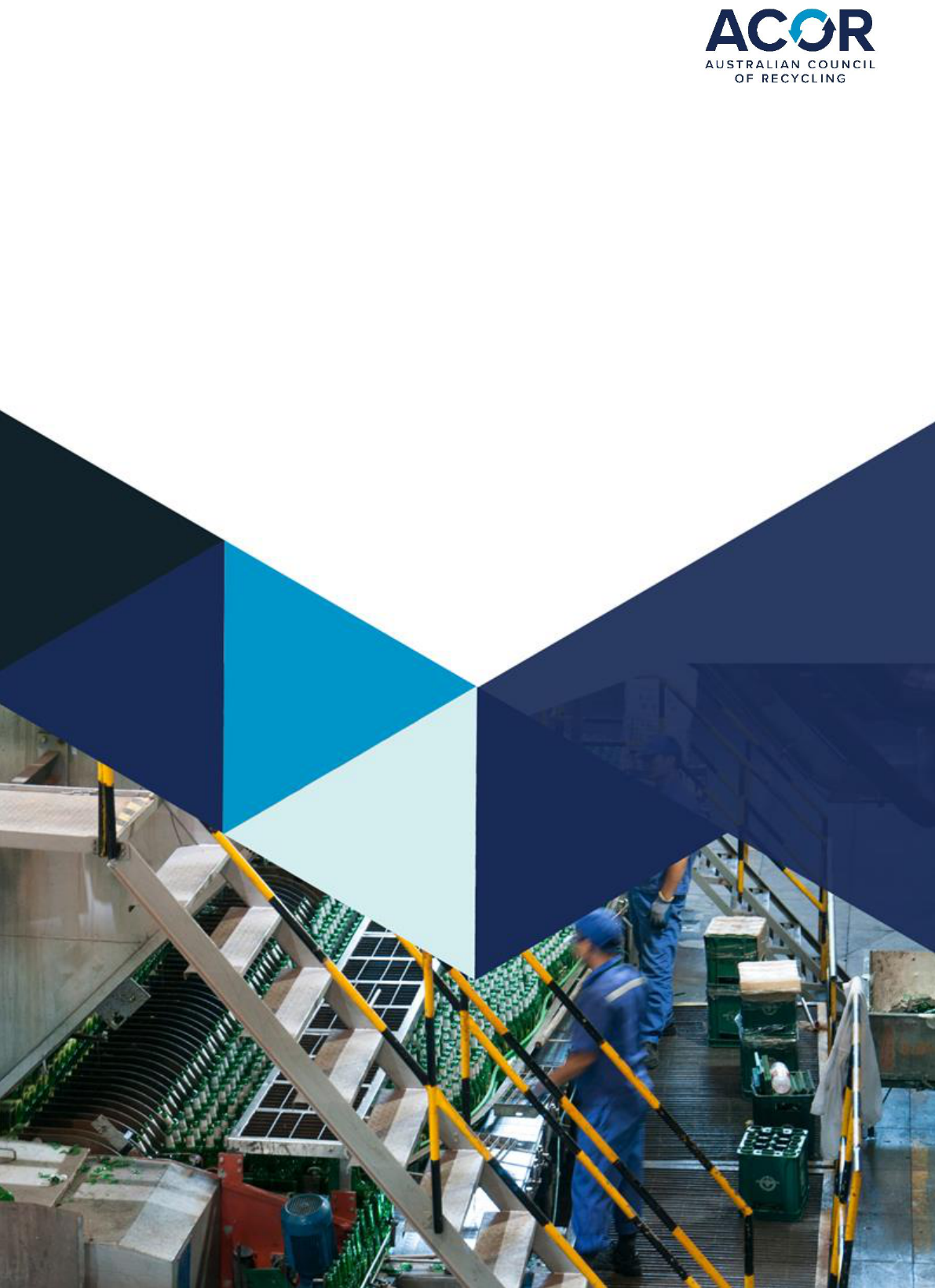
0
Recyclers in Product Stewardship
Challenges, priorities, and recommendations from the
recycling sector
Issues paper
Prepared by the
Australian Council of Recycling
April 2024
Acknowledgement of Country
We acknowledge that Aboriginal and Torres Strait Islander peoples are the First Peoples and Traditional
Custodians of Australia, and the oldest continuing culture in human history.
We pay respect to Elders past and present and commit to respecting the lands we walk on, and the
communities we walk with. We celebrate the deep and enduring connection of Aboriginal and Torres Strait
Islander peoples to Country and acknowledge their continuing custodianship of the land, seas and sky.
We acknowledge the ongoing stewardship of Aboriginal and Torres Strait Islander peoples, and the important
contribution they make to our communities, economies and the environment.
About ACOR
The Australian Council of Recycling (ACOR) is the peak industry body for the resource recovery, recycling, and
remanufacturing sector in Australia. The Australian recycling industry contributes almost $19 billion in
economic value, while delivering environmental benefits such as resource efficiency and diversion of material
from landfill. One job is supported for every 430 tonnes of material recycled in Australia.
Our membership is represented across the recycling value chain, and includes leading organisations in
advanced chemical recycling processes, CDS operations, kerbside recycling, recovered metal, glass, plastic,
paper, organic, tyre, textile, oil, battery and e-product reprocessing and remanufacturing, and construction
and demolition recovery. Our mission is to lead the transition to a circular economy through the recycling
supply chain.
1
Table of contents
Executive summary ............................................................................................................................................ 2
Summary of product stewardship challenges and solutions ............................................................................. 3
Background ..................................................................................................................................................... 4
Product stewardship and extended producer responsibility ......................................................................... 6
Recyclers: The missing link in strong product stewardship outcomes ........................................................... 8
Scheme accountability .................................................................................................................................... 9
ACCC leverage and access .............................................................................................................................. 9
Recommendations ............................................................................................................................................ 11
1. Rethink and restructure product stewardship ..................................................................................... 11
2. Design for recycling and reuse ............................................................................................................. 12
3. Create market demand ......................................................................................................................... 13
4. Enhance collection infrastructure and consumer incentives ............................................................... 15
5. Tighten scheme governance ................................................................................................................. 17
6. Enforce compliance and consequences ............................................................................................... 18
Conclusion ................................................................................................................................................... 21
Appendix 1: Governance arrangements of Australian Government-accredited schemes .............................. 22
Appendix 2: Summary of recommendations .................................................................................................... 23
Case Studies
Case Study 1: Container Deposit Schemes ....................................................................................................... 5
Case Study 2: Dutch Extended Producer Responsibility Textiles Decree .......................................................... 5
Case Study 3: REDcycle ...................................................................................................................................... 6
Case Study 4: Bureau of International Recyclers Position on Extended Producer Responsibility ..................... 7
Case Study 5: Tyre Product Stewardship Scheme ............................................................................................. 8
Case Study 6: Materials Passport and Venlo City Hall ..................................................................................... 12
Case Study 7: Seamless .................................................................................................................................... 13
Case Study 8: B-cycle ....................................................................................................................................... 16
Case Study 9: National Television and Computer Recycling Scheme .............................................................. 19
2
Executive summary
The recycling sector strongly supports an increased focus on producers and distributors (known as ‘brand
owners’) to take greater responsibility across the full lifecycle of products, including at end of use. Product
stewardship and extended producer responsibility can be an effective way to reduce waste and lift recycling
rates—particularly where recycling rates are low, or materials have low or negative value—but only if these
schemes are properly designed in partnership with recyclers.
At present, existing voluntary and co-regulated product stewardship schemes endorsed by the Australian
Government predominantly cater to brand owners. However, it is imperative to recognise that these entities
represent only a part of a product's lifecycle.
Many product stewardship schemes appropriately emphasise the waste management hierarchy priorities of
avoidance, reusability, and designing for repair, yet all products inevitably reach an end of use, where the
ideal outcome is recycling.
Overwhelmingly, when schemes do engage with recycling activities, the focus is primarily on the public-
facing, marketable elements of collection and processing, while underinvesting in the equally critical aspect
of high-value recycling outcomes and demand generation for recycled material.
Too often, cost reduction is prioritised over quality recycling outcomes in such schemes. Not only does this
undermine legitimate recycling operations, but it also erodes community confidence in recycling when the
system fails.
Recent trends indicate recovery rates for household waste have stagnated, while commercial and industrial
waste recovery rates have declined. This pattern underscores the urgent need for a concerted effort to invest
in genuine recycling outcomes.
The establishment of a scheme must not be seen as an end in itself: it must be a means to delivering
sustainable and economically viable circular outcomes, in partnership with the entire supply chain.
Engagement with the rest of the supply chain—especially recyclers, who are the subject matter experts on
recycling—is essential to ensure product stewardship schemes deliver genuine value to brand owners,
government entities, communities, and recyclers, and support the transition to a circular economy.
The recycling sector is concerned that some existing voluntary and co-regulated product stewardship
schemes are not delivering robust recycling outcomes while new schemes are being established without the
correct mechanisms in place to drive effective resource recovery and demand for recycled materials.
With thirteen industry-led government-accredited voluntary and co-regulated schemes, almost one hundred
schemes operating in Australia, and many more in development, now is the time to better align these
initiatives, set stronger targets, adopt better governance and ensure accountability, to deliver genuine
outcomes that support community confidence and proper investment in a robust and competitive recycling
value chain.
This paper outlines the priorities and challenges for recyclers in the current context of a drive towards more
stewardship and extended producer responsibility models. It recommends measures for product stewardship
schemes that will deliver better environmental outcomes and more genuine engagement across the supply
chain, including designing for recycling and reuse, expanded collection and safe disposal measures, ensuring
robust market demand for recycled materials and transparent scheme governance focussing on compliance
and consequences.
Priority areas to deliver better recycling outcomes from product stewardship are as follows:
• Rethink and restructure product stewardship
• Design for recycling and reuse
• Create robust market demand
• Enhance collection infrastructure and consumer incentives
• Tighten scheme governance
• Enforce compliance and consequences

3
Summary of product stewardship challenges and solutions
Common issues in product
stewardship schemes
Recommendaons
− Underfunding recycling
− Product stewardship
priorised above more
eecve policy and
regulatory levers
− Duplicave schemes
creang ineciency and
confusion
1.1 ‘Trigger Framework’ to determine when a product stewardship
scheme is required
1.2 Assess and embed actual costs of recovery and recycling
2.1 Federal EPR legislaon, iniated by ‘Trigger Framework’
2.2 Evidence-based targets for recyclability, with targets increasing
over me
− Weak end markets for
recycled materials
3.1 Robust end markets for Australian recycled content
3.2 Economic incenves for use of recycled materials
3.3 Minimum thresholds for Australian recycled content
3.4 Cercaon and labelling for Australian recycled content
3.5 Target dumped and subsidised imported material
− Poor governance, including
conicts of interest, and
under-representaon across
supply chain
− Scheme administraon
priorised over recycling
− Lack of appropriate targets
or proporonal
consequences for non-
achievement
4.1 Expand the scope of mandatory e-stewardship, incorporang all
consumer electronic and electrical equipment and loose and
embedded baeries into one comprehensive scheme
4.2 Gap analysis of disposal opons for all electronic and hazardous
waste streams
4.3 Comprehensive network of safe disposal sites
4.4 Incenvise safe baery collecon with deposit refund
5.1 Supply-chain representaon in product stewardship scheme
governance
5.2 Recycling sector expert convenor to engage product stewardship
schemes with recycling sector
5.3 Clearly dened and measurable objecves, rules and targets
5.4 Transparent data about objecves, decision-making processes,
recovery rates, recycling outcomes and material movement
5.5 Ensure scheme's objecves are met with accountability measures
− Poor accountability and
transparency
6.1 Australian Recyclers Accreditaon Program (ARAP)
6.2 Enforce waste export regulaons
6.3 Regulate the export of waste texles, unprocessed scrap metal and
unprocessed e-products
6.4 Tax incenves or priority access to markets for best-pracce
recycling facilies
6.5 Product stewardship schemes to be subject to third-party audits
and/or inspecons
6.6 A naonally harmonised resource recovery framework

4
Background
The Recycling and Waste Reduction Act was passed in 2020, providing a framework for managing Australia's
recycling and waste reduction objectives, which include the development of a circular economy.
1
The Act
identifies voluntary, co-regulatory and mandatory product stewardship schemes as a means to manage the
impacts of products and materials throughout their lifecycle, and enables a more accessible framework for
accreditation of voluntary schemes. The Act provides for the use of the Commonwealth’s logo for accredited
voluntary schemes, promoting the recognition and credibility that government accreditation affords.
2
The Australian Government has signalled a preference for industry action through product stewardship
schemes. The establishment of many government-accredited schemes has also been encouraged by the
Minister’s product stewardship priority list,
3
which identifies products lacking circular or recycling solutions
at their end of use.
The Product Stewardship Centre of Excellence (Centre of Excellence) was established in 2021 with the
support of the Australian Government. The Centre of Excellence maintains the Product Stewardship
Gateway, a directory of product stewardship schemes in Australia, detailing any reporting data product
stewardship schemes disclose.
In 2023, the Centre of Excellence delivered their evaluation of product stewardship and extended producer
responsibility activity in Australia,
4
in line with action 3.3 of the National Waste Action Plan 2019.
5
The
summary report presented a positive view of product stewardship in Australia, despite acknowledging
difficulties in assessing efficacy due to poor reporting from schemes:
Given the inconsistency and gaps in data collection and reporting, only a few of annual
performance indicators could be aggregated. There were also limitations in assessing how
effective initiatives are performing. For example, tonnes of waste products collected for
recovery and materials recovered were not always reported in the context of total waste arising.
Without this data, it is difficult to determine how effective the initiative has been in increasing
recovery or diverting waste from landfill.
6
Some mandatory and well-governed product stewardship schemes have been successful. State-based
container deposit schemes (CDS) will soon be operating nationwide. They are generally considered to be an
appropriately governed and funded approach by recyclers, industry and government stakeholders alike.
These mandatory schemes provide a 10-cent refund for the return of beverage containers, aligning economic
incentives with environmental goals.
1
Australian Government Department of Finance, ‘Recycling and Waste Reduction Act 2020’, Australian Government
Transparency Portal website, accessed March 2024.
2
Department of Climate Change, Energy, the Environment and Water, ‘Product stewardship schemes and priorities’,
DCCEEW website, accessed March 2024.
3
Department of Climate Change, Energy, the Environment and Water, ‘Minister’s Priority List 2023–2024’, DCCEEW
website, accessed December 2023.
4
Product Stewardship Centre of Excellence (May 2023) ‘Evaluating product stewardship: Benefits and effectiveness,
summary report’, Product Stewardship Centre of Excellence website, accessed March 2024.
5
Department of Climate Change, Energy, the Environment and Water (2019, 2022) ‘National Waste Policy Action Plan
2019’, DCCEEW website, accessed March 2024.
6
Product Stewardship Centre of Excellence (May 2023) ‘Evaluating product stewardship: Benefits and effectiveness,
summary report’, p. 10, Product Stewardship Centre of Excellence website, accessed March 2024.

5
Product stewardship and extended producer responsibility schemes are intended to encourage
manufacturers, retailers, consumers, and other stakeholders to take shared responsibility for the
environmental and human health effects of products. They aim to drive environmentally beneficial outcomes
through good design and clean manufacturing, including the use of components and materials that are easier
to recover, reuse and recycle, and often involve strategies such as designing products for recycling, creating
take-back programs for used products, and promoting responsible disposal practices.
However, all products produced or distributed in Australia ultimately reach the Australian waste stream—
including materials banned from export over the last few years. Onshore recycling and the creation of
markets for recycled materials must therefore be an overarching priority across all product stewardship
initiatives.
At a time when resource recovery rates have stagnated,
9
it is vital that recycling is prioritised. The recycling
sector plays an indispensable role in diverting materials from landfill and reintegrating them into the supply
chain, closing the loop in a circular economy.
Recycling operates as an integrated system, comprising collection, processing, and end markets for recycled
materials. In particular, markets for recycled materials are paramount; without robust markets, the system fails.
7
Total Environment Centre (2023) ‘Review: Australian Container Refund Schemes’, TEC website, p. 11, accessed
March 2024.
8
Netherlands Enterprise Agency, RVO ‘Uitgebreide Producentenverantwoordelijkheid UPV’, Business.gov.nl, accessed
March 2024.
9
Blue Environment (2022) 'National Waste Report 2022’, report to the Australian Government Department of Climate
Change, Energy, the Environment and Water, DCCEEW website, accessed March 2024.
Case Study 1: Container Deposit Schemes
Container deposit schemes (CDS) will soon be operang in every Australian state and territory.
These schemes have aracted industry and community parcipaon and substanally reduced beverage container
lier and landlling. The schemes allow for access to quality recovered material, which leads to highest-value
material reuse, such as bole-to-bole recycling. For example, the hot-wash PET ake generated from CDS products
delivers high-quality recycled PET (rPET) for the Australian packaging market. The schemes also deliver
uncontaminated glass for high-value recycling.
Through mandatory product stewardship including a 10-cent refund on returned containers, these schemes have
delivered a naonal average recovery rate of 69%,
7
collecvely resulng in the recovery of over 30 billion beverage
containers, while supporng jobs as well as fundraising for community groups.
More work now needs to be done to improve return rates to internaonal standards, achieve a naonally
harmonised approach and li governance in some schemes.
Case Study 2: Dutch Extended Producer Responsibility Textiles Decree
In the Netherlands, an extended producer responsibility scheme (Uitgebreide Producentenverantwoordelijkheid,
UPV)
8
for textiles came into effect on 1 July 2023. It establishes the following targets for reuse and recycling, which
will ratchet up over time:
• By 2025, 50% of the previous year’s total weight sold must be recovered for reuse or recycling. Of this
percentage, at least 20% must be reused, with at least half reused in the Netherlands. By 2030, it increases to
75% of the previous year’s total weight sold, with at least 25% reused of which 15% must be reused in the
Netherlands.
• By 2025, 25% of all textile fibres of discarded textile products must be used in materials for new products
(fibre-to-fibre recycling). By 2030, this must be 33% of all textile fibres.
• Producers will have to submit an annual report setting out the details of their compliance with the decree, and
are financially responsible for setting up a suitable collection and processing system for discarded textile
products. Non-compliance may be punishable with criminal law sanctions.

6
Currently, many voluntary and co-regulated product stewardship schemes frustrate higher-order recycling
outcomes by compounding a disconnect between manufacturers and recyclers, rather than fostering
partnership. This divide persists partly because manufacturers are hesitant to bear the entire expense of
recycling, which is not a cheap process in Australia, entailing higher costs than other countries in the region
due to factors including labour, energy, logistics and stringent regulations protecting the environment and
human health. Despite the challenges, the recycling sector remains indispensable in fostering sustainability
and responsible material management.
Often, scheme administrators prioritise the establishment of a scheme as an end in itself, with a great portion
of funding dedicated to administration, rather than actual and viable recycling. This emphasis on scheme
establishment rather than delivery of robust outcomes, leads to many inefficiencies, particularly in crossover
markets, as well as aggregation, and overall administration. In this sense, scheme administrators can create
duplicative systems, adding cost to recycling systems without adding value.
Product stewardship and extended producer responsibility
‘Extended producer responsibility (EPR)’ and ‘product stewardship’ refer to management approaches that
emphasise producer responsibility for end-of-use outcomes for the materials and products they place on
market. The terms are often used interchangeably as the sector matures and related initiatives expand and
proliferate, which can create confusion among stakeholders.
For the purposes of this paper, product stewardship will be used to refer to both EPR and product
stewardship unless stipulated otherwise—with a specific focus on voluntary and co-regulated schemes.
Whether EPR, or voluntary or mandatory product stewardship, or neither, is the correct approach for
managing a product at end-of-use will be determined by the nuances such as the material’s inherent value
and properties, the maturity and economic viability of the recycling supply chain and end markets, and
existing policy and regulation.
10
Australian Competition and Consumer Commission (30 March 2023) ‘Cooperation proposed to continue on soft
plastics recycling after REDcycle liquidation’, ACCC website, accessed March 2024.
11
Miles, Daniel (30 November 2023) ‘One year on from REDcycle's collapse, Australia remains without soft plastics
recycling program’, ABC News website, accessed March 2024.
Case Study 3: REDcycle
REDcycle was an industry-led program operating from 2011 as a broad-based return-to-store, soft plastics recovery
program in Australia, facilitating the collection and processing of soft plastics into a variety of durable recycled
plastic products. Product manufacturers and major Australian supermarkets partnered with REDcycle to run the
program.
In November 2022, REDcycle announced that it was suspending soft plastics collection, as processing capacity for
soft plastics and markets for recycled soft plastic products became limited.
10
It was later revealed that REDcycle was
stockpiling over 10,000 tonnes of unprocessed soft plastic across dozens of locations Australia-wide.
11
In February
2023, REDCycle was declared insolvent, reflecting broader limitations of the recycling system for soft plastic.
As a product stewardship scheme, REDcycle was fuelled by strong marketing and collection rather than a robust
recycling supply chain and stable end markets. In a market environment where the production of new plastics is still
far outstripping the demand for recycled materials, the collapse of REDcycle underscores the importance of
scrutinising the operational aspects of product stewardship schemes to ensure they are capable of fulfilling their
objectives and contribute meaningfully to circular economy outcomes.
The failure of REDcycle has had a broad impact on public confidence in recycling, with the media often calling into
question the effectiveness of Australia’s broader recycling system, demonstrating that the reputation of the
recycling industry (rather than manufacturers) is most severely compromised by poorly designed schemes.

7
Currently, product stewardship schemes in Australia largely cater to the brand owners above the interests of
the rest of the supply chain, which contains inherent risks and can result in poor environmental outcomes,
for both product stewardship schemes and EPR. These concerns are shared by the Bureau of International
Recyclers (see Case Study 4).
12
It has become increasingly apparent that many EPR and product stewardship schemes have not sufficiently
met expected targets,
13
and too much power given to only one type of stakeholder has resulted in opaque
schemes lacking checks and balances and leading to poor environmental outcomes (see Case Study 9).
12
Bureau of International Recycling (November 2023) ‘BIR Position Paper on Extended Producer Responsibility (EPR)’,
BIR website, accessed March 2024.
13
Many product stewardship schemes do not report outcomes. Of those schemes required to do so, APCO has
reported that the 2025 National Packaging Targets are on track but will not be met: APCO (2023) ‘Australian packaging
material flow analysis for 2020–21’, APCO website, accessed March 2024.
14
Bureau of International Recycling (November 2023) ‘BIR Position Paper on Extended Producer Responsibility (EPR)’,
BIR website, accessed March 2024.
What is extended producer responsibility?
Extended producer responsibility (EPR) places legal obligations on manufacturers, importers, or brand owners to
take responsibility for the end-of-use management of their products. If enacted properly, it can be an effective way
to ensure recyclability and fund recycling efforts. EPR schemes can mandate that brand owners take financial or
operational responsibility for the collection, reuse, recycling, or safe disposal of their products at the end of their
useful life.
Broader application of EPR can support greater resource efficiency if carefully implemented to avoid perverse
outcomes. There must be transparency, meaningful and enforceable targets, continuous improvement and the
input and involvement of the recycling industry, with EPR designed to work within, and improve, existing recycling
systems.
What is product stewardship?
Product stewardship schemes can be voluntary, co-regulated or mandatory initiatives, where stakeholders engage
in programs or initiatives to reduce the environmental footprint of products. Product stewardship can devolve
producer responsibility for managing the lifecycle impacts of products onto a broader pool of stakeholders,
particularly retailers, consumers and recyclers.
Case Study 4: Bureau of International Recyclers Position on Extended Producer Responsibility
14
The Bureau of International Recycling (BIR) is a global federation supporting the interests of the recycling industry.
BIR represents over 30,000 companies across 70 countries, through 37 national associations and over 1000 direct
corporate members, covering eight material streams, including ferrous and non-ferrous metals, paper, textiles,
plastics, tyres/rubber, and electrical/electronic equipment.
In 2023, BIR released a position paper on EPR highlighting growing international concern from recyclers about EPR.
Key recommendations outlined in their statement include:
• EPR schemes must not disrupt existing efficient markets, and should be set up only when there is a need and
only once the effectiveness and the intrinsic value of a waste stream have been assessed;
• governments should also consider other policy instruments to increase circularity, such as mandatory design
for recycling and legally-binding recycled-content targets;
• recyclers should be involved in the governance bodies of such schemes to ensure an appropriate balance of
interests among the most relevant stakeholders in the value chain, and;
• ownership of waste should be retained by the recycling company entrusted with the responsibility of
processing the waste, with transparent and fair tenders to avoid monopolies and comply with competition
rules.

8
Recyclers: The missing link in strong product stewardship outcomes
Critical problems arise when a key part of the scheme supply chain is unable to meaningfully engage on costs,
logistics, and the state of end markets. While product stewardship schemes are intended to operate with all
stakeholders working in concert, this is often not the case. In particular, recyclers and remanufacturers are
not sufficiently involved in the establishment or ongoing operations of schemes.
Recyclers can highlight challenges and opportunities in the recycling process, such as recyclability of
materials, components that help or hinder the recycling stream and markets for recycled materials. They are
also positioned to provide expertise into efficient collection, sorting, quality control and processing methods,
improving the overall effectiveness of the stewardship scheme and reducing contamination in recycling
streams.
Currently, recyclers and remanufacturers are under-represented on boards across product stewardship
schemes. Of the thirteen co-regulated and Government-accredited voluntary schemes in Australia, only five
publicly disclose their governance arrangements, and of those, only two show recyclers on the board (as
shown in Appendix 1: Governance arrangements of Australian Government-accredited schemes.
The involvement of recyclers in the governance of product stewardship schemes can help to ensure that
recycling is economically viable and drive market demand for recycled materials. With rising costs across
recycling facilities, it is particularly critical that recyclers are at the table to highlight market failures, to inform
whether, and when, intervention through a product stewardship scheme is necessary.
15
Australian Competition and Consumer Commission (May 2018) ‘ACCC re-authorises Tyre Stewardship Scheme’,
ACCC website, accessed January 2024.
Case Study 5: Tyre Product Stewardship Scheme
Tyre Stewardship Australia (TSA), which commenced in 2014, raises a 25 cent per tyre levy from participating tyre
manufacturers, amounting to $7.6 million in 2023. These funds are distributed across three primary functions:
research and development for new end-of-life-tyre (EOLT) products; an accreditation program for collectors,
recyclers and retailers; and consumer marketing.
TSA is a manufacturer-led and governed organisation. There is no recycling industry representation on the board
and little overall strategic engagement with the recycling sector. TSA has no role in the collection and recycling of
EOLTs, and no funds from the scheme are provided to the sector. In the year ending June 2023, while TSA’s levy
income increased by 20%, spending on market development dropped to one-quarter of the company’s spending
(47% went to consultancy expenses, advertising and marketing).
This lack of engagement with the recycling sector has led to some ill-informed decisions. For instance, by
accrediting ‘balers’ (the cheapest disposal option for tyre retailers), prior to the Australian Government’s ban on
the export of whole baled tyres, TSA effectively endorsed many millions of unprocessed EOLTs to be exported to
developing countries in our region and to very poor environmental outcomes such as open burning.
The ACCC recently acknowledged concerns raised by sector stakeholders in relation to the effectiveness of the
scheme, citing insufficient representation on the TSA board, particularly in relation to the tyre recycling sector.
15
Stakeholders identified further concerns stemming from this lack of representation, including the accreditation,
under the scheme, of businesses that were uncompliant with scheme objectives, and insufficient oversight of
unprocessed EOLT’s exported overseas.
ACCC- and Government-endorsed product stewardship schemes are often called on to speak as authorities on
recycling, or are credited with recycling outcomes. TSA, for example, points to increased EOLT recovery rates since
the scheme’s formation as demonstration of its success; however, this change should more appropriately be
credited to tightened state-based regulation: over the same time period, every state substantially reformed
regulation of the storage, transportation, fire safety, end-of-use disposal and other environmental management
aspects of EOLTs. Together, these regulatory changes provided an impactful disincentive to stockpiling EOLTs and
fostered increased recycling investment and activity.
TSA is lobbying the Australian Government to intervene in the sector via regulated product stewardship, despite a
97% collection rate for used passenger and commercial tyres. Since state regulations to limit stockpiling and illegal
dumping have been effective, it is unclear what environmental outcome a regulated scheme would deliver.

9
Scheme accountability
Government-backed schemes must deliver genuine circular economy and recycling outcomes. One way to
deliver meaningful outcomes is to ensure that schemes are advancing progress towards the targets in the
National Waste Policy Action Plan and Australia’s 2025 Packaging Targets,
16
specifically:
• reducing the total waste generated in Australia by 10% per person by 2030
• achieving an 80% average recovery rate from all waste streams by 2030
• phasing out problematic and unnecessary plastics by 2025
• halving the amount of organic waste sent to landfill by 2030
• 100% of packaging being reusable, recyclable or compostable by 2025
• 70% of plastic packaging being recycled or composted by 2025
• 50% of average recycled content included in packaging by 2025.
Accountability at present is insufficient to ensure best-practice operations and high-value recycling
outcomes. A history of self-reporting with little benchmarking or consideration for tangible targets appears
to have fostered a culture of accepting any increase in material collection as ‘success’ of some schemes (see
Case Study 5). This self-reported data often goes unchallenged, even where issues are brought to the ACCC’s
attention, leading to reduced confidence and ultimately constraining investment in new recycling capacity
and capability.
17
Product stewardship schemes in Australia are also able to run their own accreditation programs for recyclers,
establishing specific criteria and standards that recyclers must meet to participate in their schemes. These
criteria typically focus on factors such as operational processes, compliance with regulations, the ability to
meet quality standards for recycled materials, and (ideally) environmental impact. Recyclers seeking
accreditation usually undergo assessments, audits, and evaluations to ensure they meet these set standards
before being approved to participate in the product stewardship schemes.
These ‘bespoke’ accreditation programs for recyclers represents a conflict of interest insofar as the priority
of schemes is to keep recycling costs low, rather than ensure best-practice recycling outcomes (see Case
Studies 7 and 9). This is costly and inefficient for both recyclers and brand owners, given that some recyclers
service more than one scheme and are therefore required to be separately accredited. For example, in the
mandatory National Television Computer and Recycling Scheme, recyclers must be approved by each and
every co-regulator that they supply, resulting in duplication of effort.
Product stewardship schemes must ensure transparency, accountability and effectiveness. In particular,
schemes that are accredited by the Australian Government must be required to meet a much higher standard
of governance, transparency and material outcomes.
ACCC leverage and access
Federal accreditation is a six-month process that enables industry-led product stewardship operations to
demonstrate to businesses and consumers that the arrangement has the Australian Government’s stamp of
approval.
18
An ACCC authorisation can also be granted, where schemes can be exempted from competition provisions—
such as those guarding against anti-competitive and cartel-like behaviours—and the ACCC may grant
protection from legal action for conduct that might otherwise breach the Competition and Consumer Act
2010 (the Act). Schemes seek authorisation where they wish to engage in conduct that is at risk of breaching
the Act but nonetheless consider there to be public benefit.
16
Department of Climate Change, Energy, the Environment and Water (2019, 2022) ‘National Waste Policy Action Plan
2019’, DCCEEW website, accessed March 2024.
17
Australian Tyre Recyclers Association (2 February 2024) ‘Authorisations register: Tyre Stewardship Australia
Limited’, submission, ACCC website, accessed March 2024.
18
Department of Climate Change, Energy, the Environment and Water (March 2023) ‘Product stewardship
accreditation’, DCCEEW website, accessed March 2024.

10
Since product stewardship should align with broader public interest by promoting sustainability, reducing
waste, and safeguarding environmental and public health, ACCC authorisation affords schemes access to a
suite of anti-competitive instruments,
19
such as:
• cartel conduct,
• contracts, arrangements or understandings
containing anti-competitive provisions,
• exclusive dealing,
• misuse of market power,
• secondary boycotts, and
• resale price maintenance.
While ACCC authorisation can support the delivery of public benefit through a product stewardship scheme,
some schemes have elicited commercial in-confidence data from the recycling industry through their ACCC
authorisation, which has subsequently been used to benefit brand owners of the scheme, rather than support
a whole-of-supply-chain stewardship outcome.
20
Some schemes also seek to conflate the achievements of
the recycling sector with those of the scheme (see Case Study 5).
19
Robert Janissen (3 September 2021) ‘ACCC Authorisation for product stewardship schemes’, webinar, Product
Stewardship Centre of Excellence website, accessed March 2024.
20
Australian Tyre Recyclers Association (2 February 2024) ‘Authorisations register: Tyre Stewardship Australia
Limited’, submission, ACCC website, accessed March 2024.
11
Recommendations
1. Rethink and restructure product stewardship
While product stewardship and EPR schemes can have positive outcomes if operated fairly and transparently,
to ensure best practice there needs to be greater critical consideration of the market conditions and
alternative approaches before new product stewardship schemes are established.
Consideration should be given as to whether product stewardship should be the only mechanism to be
instituted. Other effective mechanisms, such as higher landfill levies, landfill bans, product bans and the
enforcement of existing regulation, will be effective in some sectors, and often more cost-effective. Many of
these policy mechanisms are blunt instruments that do not place responsibility and costs on the brand owner.
EPR should be considered amid this range of policy options, and prioritised where adequate funding is not
available for optimum end-of-life solutions, or where there is significant market failure.
Product stewardship schemes should be considered as a mechanism to support the development of
infrastructure and markets for recycled materials, encourage correct collection, and increase end producer
responsibility. If a robust end market exists with adequate investment in recycling and resource recovery, a
scheme could, where appropriate, be wound down.
Product stewardship schemes are more appropriate and effective when applied to new recycling supply
chains—or where collection and recycling rates are low—rather than retrofitting to mature recycling
markets. Uncertainty about how new schemes might be established will deter investment in particular
material streams, with a potential domino effect on investment confidence across broader recycling streams.
There is a need for clarity about where the Australian Government will, and will not, intervene, with a priority
of engaging closely with the recycling sector to ensure that domestic investment is not disrupted or
undermined.
A product stewardship scheme ‘Trigger Framework’ could define clear parameters about when a scheme
should be initiated for a product, or whether a new product or category should be added to an existing
scheme in order to improve efficiency and minimise duplication of effort. Ensuring all parties in the supply
chain know schemes will be triggered once a set of transparent criteria are met—alongside consultation with
relevant supply chain stakeholders, including the recycling sector—will foster market and investment
confidence.
While end markets are key to driving recycling, there will often remain a recycling cost to be covered by a
credible scheme that distributes risk equitably across the supply chain. In sectors where there are low
recovery rates, or the free market does not support an economically viable recycling system, levies must
represent the real cost of recovery and recycling, take into consideration different recycling outcomes that
can deliver lower and higher value outputs, and support recycling development innovation.
Scheme funding that falls short of covering the cost of recycling fundamentally undermines genuine recycling
outcomes.
RECOMMENDATION 1.1 ‘Trigger Framework’ to determine when a product stewardship scheme is
required
In consultation with recyclers, brand owners and sector experts, the Australian
Government should establish a transparent ‘Trigger Framework’ to determine
when a product stewardship scheme becomes necessary: when certain market
conditions exist or recovery rates stagnate or fall. This framework must include
consultation with all supply chain stakeholders, particularly recyclers.
Attached to the ‘Trigger Framework’, an exit conditions metric should be
outlined for every new scheme, dictating under what economic and
environmental conditions and recycling rates a scheme could be wound down,
repositioning some schemes as tools for market rehabilitation and not an end in
themselves.

12
RECOMMENDATION 1.2 Assess and embed actual costs of recovery and recycling
Ahead of endorsing any product stewardship or EPR scheme, the Australian
Government should work with the recycling sector to conduct a comprehensive
assessment of the actual costs of recovery, recycling and remanufacture of
relevant material streams. This assessment should consider the entire recycling
value chain, including collection, logistics, sorting, processing and markets for
recycled materials, and would inform appropriate scheme fees and financing.
Governments must ensure that extended producer responsibility measures
undertaken by product stewardship schemes address actual costs of recovery and
recycling, support genuine and highest-value recycling outcomes, and investment
in Australian recycling.
2. Design for recycling and reuse
One of the biggest challenges to material recovery at end of use is poor design. A key component for every
product stewardship scheme must be to ensure that brands and brand owners design for better material
recovery and reuse, with a priority of procuring recycled materials.
Around the world, innovative closed-loop solutions are being deployed independently of product
stewardship schemes. For example, an aid in the correct sorting of materials for reuse is the ‘materials
passport’.
21
Through smart material choices and designing for disassembly, these materials passports will
make it possible for manufacturers to recoup some of their original investment, as materials can be sold back
into the supply chain, and ultimately used again.
It is understood that relatively few products are manufactured in Australia; however, given that all products
distributed in Australia ultimately enter into Australian waste streams, it is vital that schemes implement
measures to influence design for the Australian market.
Adopting more robust EPR regulations enforces producer responsibility for the entire lifecycle of their
products, including collection, recycling, and remanufacture. This, in turn, encourages the design of products
that are easier to disassemble, reuse, or recycle.
RECOMMENDATION 2.1 Federal EPR legislation, initiated by ‘Trigger Framework’
The Australian Government should implement Extended Producer Responsibility
legislation that holds manufacturers responsible for the end-of-use management
of their products, to encourage circular design and increase the demand for
recycled materials. This EPR legislation should only be initiated when conditions of
a ‘Trigger Framework’ (RECOMMENDATION 1.1) have been met.
21
Cradle to Cradle, ‘City Hall Venlo‘, C2C Venlo website, accessed March 2024.
22
Ellen Macarthur Foundation (June 2021) ‘City Hall from Cradle to Cradle: Venlo’, Ellen Macarthur Foundation
website, accessed March 2024.
23
Kraaijvanger Architects, ‘Municipal Office Venlo’, Kraaijvanger website, accessed March 2024.
Case Study 6: Materials Passport and Venlo City Hall
In the Netherlands, a ‘materials passport’ innovation was deployed during the construction of Venlo City Hall. The
passport records exactly what goes into the building, and will support the correct sorting of materials for reuse.
All components of the building were documented during construction in a materials database—or ‘materials
passport’—that describes the materials and provides an end-of-use plan, such as how to disassemble and recycle or
return them to the manufacturer. By effectively creating a materials bank within the walls of the City Hall and
designing for disassembly, it will be possible to recoup some of the original investment, at a later date, as materials
can be sold back to manufacturers through a ‘buy and buy-back’ scheme, and ultimately used again.
22
Furthermore, during its construction numerous producers and suppliers acquired Cradle to Cradle (C2C)
certifications for their products.
23

13
RECOMMENDATION 2.2 Evidence-based targets for recyclability, with targets increasing over time
Overseen by the Australian Government, product stewardship schemes should set
evidence-based targets for reuse and recyclability within product categories that
are reusable/recyclable and those that are not. Targets for reusability and
recyclability should increase over time, with measures in place to hold brand
owners and distributors to account.
3. Create market demand
Too often, product stewardship advocates appear to consider the establishment of a scheme as an end in
itself—in terms of meeting sustainability obligations—rather than a means to this end. A thriving and scaled
recycling sector is an essential component of a functioning circular economy—and recycling cannot function
without robust markets for recycled materials.
Theoretically, anything is recyclable, but recycling at scale must be economically viable, addressing the cost
of Australian labour, logistics, compliance, infrastructure, research and development, and, most critically,
supporting end markets for recycled materials.
There are significant barriers to strong market uptake of recycled material, including cost competitiveness
with virgin materials and willingness within the supply chain to embrace change. To date, an uneven
approach has been taken by the Australian Government, with a focus on banning the export of ‘waste’
without measures to address imported products that ultimately enter Australian waste streams. Conversely,
there are no drivers to address the import of products that ultimately all become Australian waste, at end of
use, as well as imported virgin and recycled materials that compete with Australian recycled products.
While there must be strong prioritisation of domestic end markets, export markets for processed recycled
commodities should be recognised as a legitimate avenue, akin to any other exported commodity, noting
that the focus must be on domestic processing.
24
Monash Sustainable Development Institute (2022) ‘Textiles: A transitions report for Australia identifying pathways
to future proof the Australian fashion and textile industry’, report, p. 6, Monash University website, accessed April
2024.
25
Australian Fashion Council (18 December 2023) ‘Seamless announces inaugural CEO and Board of Directors’, media
release, Australian Fashion Council website, accessed February 2024.
26
Australian Fashion Council (2023) ‘Scheme Design Summary Report’, Australian Fashion Council website, accessed
February 2024.
Case Study 7: Seamless
Australians are the second-largest consumers per capita of textiles globally, purchasing on average an estimated
27 kilograms of new fashion and textiles each year, of which on average 93% is disposed of.
24
In 2018–2019,
227,000 tonnes of clothing were landfilled in Australia, 105,900 tonnes were exported, 51,000 tonnes were reused
locally, 7,000 tonnes were recycled and 5,000 tonnes went to waste to energy.
The Australian Fashion Council clothing product stewardship scheme, Seamless, launched in June 2023. The Board
was announced in in December 2023,
25
with no representation from the recycling sector.
The scheme design outlined a proposal to reduce this consumption and waste by raising a levy of 4 cents per
garment to be invested in education, scheme administration, and research and development
26
.
This levy does not adequately address the costs of recycling and the scheme design in fact risks potentially locking in a
status quo arrangement in the fashion industry: restricting trade and access to feedstock, and remuneration for recyclers.
The scheme design does not address the economic and regulatory mechanisms necessary to drive resource
recovery: there are no identified end markets for recycled products generated by the scheme and no firm work
plans to develop these markets; no restrictions on the export of textile waste; no landfill bans (noting that some
participants are entitled to a waste levy exemption); and insufficient funding for higher-order recycling.
Under the current design, Seamless will likely raise revenue from consumers while increasing export revenue from
used textiles (including textile waste), without increasing Australian recycling rates.

14
Establishing a circular economy underpinned by a strong recycling sector will require the correct economic
drivers. For example, mandated recycled plastic content in the United Kingdom has catalysed investment in
recycled polymers by creating market demand.
27
Requiring manufacturers to use a certain percentage of
recycled content in their products has created a stable market for recycled polymers, encouraging investment
in recycling infrastructure and technologies to meet this demand.
In Australia, many in the recycling industry advocate for the mandatory implementation of the 2025 National
Packaging Targets set out in the Australian Packaging Covenant Organisation. In 2023, the Australian
Government committed to regulate packaging and ultimately enforce these targets:
28
the creation of robust
end markets by 2025, ensuring that packaging incorporates 50% recycled content on average, and achieving
100% reusability, recyclability, or compostability.
29
While not yet defined, it is anticipated that the scope of
this regulation will encompass all packaging sold in Australia, accompanied by consistent benchmarking and
transparent reporting.
Formal government adoption of these targets would provide substantial backing for a flourishing,
competitive recycling sector by mandating recycled content in packaging. This would support the integration
of recycled products and materials into supply chains, fostering resilient and strong end markets.
Circular agreements can also play a useful role in fostering downstream end markets.
30
RECOMMENDATION 3.1 Robust end markets for Australian recycled content
Product Stewardship schemes must prioritise demand generation and play an
active and specific funded role in directly supporting robust and viable end
markets for Australian recycled materials.
RECOMMENDATION 3.2 Economic incentives for use of recycled materials
The Australian Government should create economic incentives for using recycled
materials, such as tax incentives, subsidies, grants, or differentiated regulatory
fees, which can offset the cost difference between recycled and virgin materials,
making the use of recycled materials more financially attractive for businesses.
Incentives to use recycled materials specifically derived from product stewardship
schemes should be considered.
RECOMMENDATION 3.3 Minimum thresholds for Australian recycled content
All Governments should implement strong drivers and mandated procurement
targets to support uptake of Australian recycled content, such as a price signal to
prioritise Australian recycled content over virgin materials and mandatory
minimum thresholds for Australian recycled content.
RECOMMENDATION 3.4 Certification and labelling for Australian recycled content
The Australian Government should work with industry to establish certification
and labelling programs that identify products made from recycled materials to
help consumers make informed choices and increase demand by driving
manufacturers to incorporate more recycled content.
RECOMMENDATION 3.5 Target dumped and subsidised imported material
The Australian Government should support a level playing field for the Australian
recycling market by more strongly targeting dumped and subsidised imported
materials.
27
NetZero Pathfinders, ‘Recycled Content Mandates: U.K.’, Bloomberg website, accessed March 2024.
28
Department of Climate Change, Energy, the Environment and Water, ‘Reforming packaging regulation’, DCCEEW
website, accessed March 2023.
29
APCO, ‘Australia’s 2025 National Packaging Targets’, APCO website, accessed March 2024.
30
Steve Morriss (1 February 2024) ‘Circular Contracts: The future of recycling’, Close the Loop blog, accessed March
2024.

15
4. Enhance collection infrastructure and consumer incentives
While some product stewardship schemes have achieved desirable collection rates for end-of-use items, this
is not the case across all product categories. Schemes that provide little incentive for consumers to return
items to away-from-home collection points, and/or haven’t supported a comprehensively accessible and
well-marketed collection network, generally have poor collection rates.
31
Of major concern are items that pose a risk across all other collection and recycling streams, such as those
containing loose or embedded batteries which cause fires in waste and recycling trucks and facilities. The
rapid digitisation and electrification of everyday items, the increasing number of ‘smart’ and disposable items
such as vapes containing embedded and sealed batteries, and a lack of consumer education around their safe
collection, have all contributed to the steep and hazardous rise in batteries in inappropriate waste streams.
32
There is considerable confusion about which items contain batteries and which schemes different electronic
products are subject to. For example, it is not widely understood that vapes and digital thermometers contain
batteries. Also, while there are an array of schemes addressing electronic and electrical products—including
the mandatory National Television Computer and Recycling Scheme (NTCRS), the voluntary Mobile Muster
scheme, and the voluntary B-cycle scheme—many items are not accepted by any of these schemes, leaving
gaps for necessary collection and creating confusion in the community about appropriate disposal options.
Despite this critical lack of access to safe collection locations for these items, to date no comprehensive
geographic mapping of the gaps has been undertaken. Even with a product stewardship scheme in place, if
there are limited accessible safe disposal avenues, the only options for the community are to stockpile, litter
or dispose into incorrect waste streams.
Not only is there insufficient infrastructure to collect such items safely and comprehensively, but there are
also no compelling drivers to divert these types of products from conventional recycling streams (such as
household bins), resulting in major hazards across the recycling sector.
As the Australian Government reviews the framework for e-stewardship, it is essential that all e-products
(including those with batteries) are addressed holistically, rather than the current piecemeal approach.
There must be comprehensive access for collection, as well as compelling incentives for consumers to return
items to appropriate drop-off locations—especially items that pose a risk to human health, the environment
or conventional waste and recycling systems.
Highest-value recycling outcomes are achieved through well-sorted and separated recovered products and
materials.
At a consumer level, there must be a strong incentive to safely dispose of these products through the
introduction of a refund or deposit scheme, similar to container deposit schemes. This will help to drive the
correct collection of products at end of use, which is critically important for items that are hazardous, such
as loose and embedded batteries. Concerns that a refund on batteries might expose consumers to risk can
be addressed by ensuring that refunds are contingent on safe collection practices and appropriate
community education.
31
For example, in 2023, B-cycle’s collection rate of in-scope loose batteries was 12%. See B-cycle (July 2023) ‘Positive
Charge: 2022–2023 Report’, B-cycle website, accessed March 2024.
32
ACOR (December 2023) ‘A Burning Issue: Navigating the battery crisis in Australia’s recycling sector’, ACOR website,
accessed March 2024.

16
RECOMMENDATION 4.1 Expand the scope of mandatory e-stewardship, incorporating all consumer
electronic and electrical equipment and loose and embedded batteries into one
comprehensive scheme
The Australian Government should expand the scope of mandatory
e-stewardship, incorporating all consumer electronic and electrical equipment
into one comprehensive scheme—including any product connected to a plug or
that contains batteries, as well as all loose and embedded batteries, to bring
Australia into line with European standards.
RECOMMENDATION 4.2 Gap analysis of disposal options for all electronic and hazardous waste streams
State and Territory Governments must conduct a detailed gap analysis of disposal
options for all electronic and hazardous waste streams, to help inform future
schemes and policy decisions.
RECOMMENDATION 4.3 Comprehensive network of safe disposal sites
State and Territory Governments must ensure that a comprehensively accessible
network of safe disposal options is provided to all Australians for materials that
are hazardous in conventional waste and recycling streams, such as loose and
embedded batteries, supported by strong community education campaigns.
RECOMMENDATION 4.4 Incentivise safe battery collection with deposit refund
Product stewardship schemes must strongly incentivise safe collection of batteries
at end of use by introducing a deposit refund for safe disposal at appropriate
collection points.
33
Battery Stewardship Council (December 2023) ‘Circular Batteries Australia Position Paper’, p. 7, B-cycle website,
accessed March 2024.
34
Lisa Korycki (29 February 2024) ‘Ecocycle flags e-waste recycling challenges’, Waste Management Review, accessed
March 2024.
35
B-cycle (July 2023) ‘Positive Charge: 2022–2023 Report’, B-cycle website, accessed March 2024.
Case Study 8: B-cycle
B-cycle, which launched in January 2022, is an ACCC-authorised product stewardship scheme for loose batteries,
run by the Battery Stewardship Council.
The B-cycle scheme accepts all small loose and easily removable batteries, including regular AA and other sizes,
button batteries, rechargeable batteries, and small removable batteries from devices like hearing aids, power tools,
e-bikes and digital cameras, but does not accept embedded batteries, batteries over 5 kilograms, mobile phone or
laptop batteries, lead acid batteries or exit lighting. Not all loose batteries are within the scope of the scheme, and
determining which batteries are in or out of scope remains confusing even for those working in the sector.
The authorisation by the ACCC identified that a levy would be applied to imported batteries at a rate of 4 cents per
24 grams, and would be used to fund the scheme and a rebate system for service providers responsible for the
battery’s collection, sorting and processing. However, the scheme only applied a 2 cent levy at its inception, raising
this amount to 3 cents in 2022 and subsequently applying the 4 cent levy at the beginning of 2024.
33
Meanwhile, Australia’s battery recyclers have identified that the B-cycle funding for recycling is insufficient.
34
In
2023, the collection rate was 12% of loose in-scope batteries.
35
Some battery manufacturers and retailers are in competition with B-cycle, in an effort to pursue better recycling
outcomes more efficiently. Those who independently pay for their batteries to be recycled can achieve higher-value
outcomes by paying the recycler directly, rather than paying a levy to B-cycle on one hundred per cent of products
for the lower rate of recycling.

17
5. Tighten scheme governance
Governments and industry are increasingly relying on product stewardship schemes to meet circular
economy principles. A properly functioning circular economy requires participation from every stage of the
supply chain. Currently, these schemes typically represent only one stage of the circular economy supply
chain: producers and distributors (also known as brand owners).
Many existing product stewardship schemes are not neutral bodies, but rather reflect the interests of brand
owners over the rest of the supply chain, including recyclers. To effectively deliver a circular economy,
product stewardship schemes must have a governance structure that equitably represents every stage of the
supply chain.
Product stewardship schemes often exclude the recycling sector—tasked with delivering the scheme’s
ultimate outcomes—from meaningful participation in scheme governance, development and design. It is
essential that the entire supply chain should participate in establishing a scheme’s goals and ongoing
operation, through adequate representation on scheme boards.
Stakeholder governance is increasingly acknowledged as a path for organisations to better address
environmental, social and governance (ESG) considerations,
36
with conflicts of interests addressed through
compliance with director’s responsibilities, including fiduciary duties.
37
Scheme governance can also include
community and council representatives. An independent chair may also help to address producer dominance
of schemes.
Effective stakeholder representation in product stewardship scheme leadership is particularly pressing in
light of the ACCC’s recently prioritised focus on environmental claims, and given that every product
stewardship initiative aims to collect and recycle their products. Schemes must deliver genuine recycling
outcomes in order to support a circular economy and community confidence in recycling.
Transparent, objective and consistent data and reporting is also required to assess scheme efficacy against
rigorous targets.
RECOMMENDATION 5.1 Supply-chain representation in product stewardship scheme governance
Product stewardship schemes must have supply-chain representation within
their governance structures. This should comprise an independent Chair, and a
Board that includes representatives and expertise from all stages of a circular
supply chain, with equal decision-making powers and formal channels to provide
expertise. Recycling industry representation should be proportionate to the
operational costs borne for the actual recycling of the product waste stream.
RECOMMENDATION 5.2 Recycling sector expert convenor to engage product stewardship schemes with
recycling sector
To address RECOMMENDATION 5.1, establish and adequately resource a recycling
sector expert convenor, under the auspice of the Australian Council of Recycling,
to facilitate engagement with subject matter experts and leaders in the recycling
sector and provide guidance and board directors to schemes.
36
Zishu Chen (June 2022) ‘Corporate governance: Meet the new champions of stakeholder capitalism’, World
Economic Forum website, accessed March 2024.
37
Various frameworks and guidelines set out directors’ responsibilities regarding environmental outcomes, including
the European Commission’s Corporate Sustainability Due Diligence Directive, the UN's Guiding Principles on Business
and Human Rights, and the OECD’s Guidelines for Multinational Enterprises and Due Diligence Guidance for
Responsible Business Conduct.

18
RECOMMENDATION 5.3 Clearly defined and measurable objectives, rules and targets
Schemes should have objectives, rules and targets that are clearly defined and
measurable, to track progress, evaluate the effectiveness of the scheme, and
make necessary adjustments over time. Well-defined metrics—especially
regarding recycling and scheme compliance from all parts of the supply chain—
will identify areas for improvement and highlight successes.
RECOMMENDATION 5.4 Transparent data about objectives, decision-making processes, recovery rates,
recycling outcomes and material movement
All stakeholders should have access to information about the scheme’s
objectives, decision-making processes, recovery rates, recycling outcomes and
material movement, reported at a state level. This transparency helps prevent
conflicts of interest when tendering for services and ensures that the scheme’s
actions align with its intended goals.
RECOMMENDATION 5.5 Ensure that the scheme’s objectives are met with accountability measures
Stakeholders within schemes should be incentivised to actively participate in and
contribute to the circular economy, particularly recycling. There must be
mechanisms for holding participants accountable to commitments and actions in
place to ensure that the scheme’s objectives are met.
6. Enforce compliance and consequences
Ensuring compliance with existing regulations must be a priority to increase recycling rates, along with a
harmonised accreditation scheme that supports best-practice recycling outcomes.
‘Bespoke’ accreditation systems for schemes effectively lead to schemes self-reporting, while creating
excessive costs and inefficiencies for both recyclers and brand owners.
Conflict of interest can also go unchecked when schemes develop their own accreditation systems for
recyclers, for example, by emphasising cost-cutting measures over high-quality results.
38
Scheme
accreditations can introduce uncertain and untrustworthy data, undermining confidence and ultimately
limiting investments in expanding new recycling capacities and capabilities.
ACOR has scoped the value of a national accreditation program for Australian recyclers, and is now working
with industry and government to advance the establishment to provide a framework for independent,
objective and consistent assessments that determine whether a recycling site is operating to a specified
standard in a secure, sustainable and resilient manner.
While it is crucial to ensure that recyclers are operating legitimately, it is also a priority to address the
fragmented, variable and duplicative regulatory environment across Australia’s States and Territories. There
must be a nationally harmonised resource recovery framework to prioritise circular economy outcomes,
define ‘end of waste’ and support investment confidence in recycling. There must also be much more
effective enforcement of Australia’s waste export regulation and a broadening of this regulation to address
other materials—including textiles and unprocessed scrap metal—to ensure that Australia’s international
environmental duties are met, and Australia’s recycling capabilities are supported. The cost of this regulation
should be placed on producers and distributors, who are responsible for the products placed on market, not
on the recycling sector.
38
For examples, refer to the included case studies.

19
RECOMMENDATION 6.1 Australian Recyclers Accreditation Program (ARAP)
The Australian Government should support compliance through the
implementation and adoption of an Australian Recyclers Accreditation Program
(ARAP).
40
RECOMMENDATION 6.2 Enforce waste export regulations
The Australian Government should more effectively and proactively enforce
existing waste export regulations, with impactful consequences including fines
and imprisonment. The cost of regulation should be placed on producers and
distributors, who are responsible for products placed on market.
RECOMMENDATION 6.3 Regulate the export of waste textiles, unprocessed scrap metal and unprocessed
e-products
The Australian Government should expand the existing waste export rules to
specifically address waste textiles, unprocessed scrap metal and unprocessed e-
products.
RECOMMENDATION 6.4 Tax incentives or priority access to markets for best-practice recycling facilities
The Australian Government should create incentives, such as tax incentives or
priority access to markets, for recycling facilities that consistently demonstrate
high levels of compliance.
39
Department of Climate Change, Energy, the Environment and Water, ‘National Television and Computer Recycling
Scheme’, DCCEEW website, accessed March 2024.
40
Australian Council of Recycling, ‘Australian Recyclers Accreditation Program’, ACOR website, accessed March 2024.
Case Study 9: National Television and Computer Recycling Scheme
The National Television and Computer Recycling Scheme (NTCRS),
39
established in 2011, provides collection and
recycling services for televisions and computers, including printers, computer parts and peripherals. The scheme is
intended to reduce e-waste to landfill, increase the recovery of reusable materials, and provide convenient access
to recycling services for households and small businesses.
Companies who import or manufacture television and computer products over certain thresholds are liable under
the scheme, and are required to pay for a proportion of recycling through membership in an approved co-
regulatory arrangement. These five co-regulators are responsible for the day-to-day operation of the scheme,
including organising collection and recycling of e-waste on behalf of brand owners (known as liable party members
within the NTCRS).
However, the NTCRS has become an inefficient system with a two-tiered marketplace: the five co-regulators
compete to offer the lowest fees to brand owners, forcing prices down to unsustainable levels, while recyclers are
reduced to price-takers. The NTCRS has become a ‘race to the bottom’ for some brand owners at the expense of
best-practice recycling and environmental outcomes.
The drive towards low-cost outcomes has incentivised some co-regulators to reduce accessibility, or compromise
on material recovery rates. There is little transparent downstream verification or reporting of recycling outcomes:
audits in the NTCRS are primarily financial audits, with cursory attention to operational elements.
The Department of Climate Change, Energy, the Environment and Water is currently leading a redesign of the
NTCRS to broaden the parameters of e-stewardship regulation to likely include all small electrical and electronic
products as well as solar photovoltaic systems. The revised scheme must address the NTCRS’s inefficiencies and
inherent conflicts of interest, while driving a properly comprehensive approach to e-stewardship, incorporating all
consumer electronic and electrical equipment and loose and embedded batteries.
20
RECOMMENDATION 6.5 Product stewardship schemes to be subject to third-party audits and/or
inspections
The Australian Government should require regular independent audits to assess
compliance with regulations and internal policies, holding stewardship schemes to
greater account via more vigilance, auditing and assessment of claims made by
schemes regarding performance, industry data and reporting protocols. Third-
party audits and/or inspections—underpinned by circular principles—should also
be implemented to provide unbiased assessments of compliance and identify
areas for improvement.
RECOMMENDATION 6.6 A nationally harmonised resource recovery framework
The Australian Government, together with State and Territory Governments,
should establish a nationally harmonised resource recovery framework, to
prioritise circular economy outcomes, define ‘end of waste’ and support
investment confidence in recycling.
21
Conclusion
This paper has outlined some of the challenges for recyclers in the current operations and mandates of
product stewardship schemes. As governments and industries look towards greater product stewardship and
extended producer responsibility (EPR) models as a key tool in the circular economy, it is vital that we
encourage a more transparent, inclusive and effective dialogue around their establishment and viable
operations. Greater collaboration will ultimately lead to product stewardship schemes that deliver more
benefits for brand owners, governments, the community and recyclers.
It is essential to the success of any recycling operation, regulation or policy that recyclers and
remanufacturers have a seat at the table, and are consulted often and with intention. In product stewardship
schemes, brand owners represent only a small fraction of the mechanism, but hold the most authority and
decision-making power. As a key part of the supply chain, the recycling, resource recovery, and
remanufacturing sector is essential to ensure product stewardship schemes deliver a circular economy. To
date, this sector’s experience and expertise has largely been overlooked at best, or systematically ignored at
worst.
Ultimately, the key recommendations contained in the paper are an offer from our sector to collaborate,
share our expertise and find a path forward to work together with government and industry to achieve a
thriving circular economy.

22
Appendix 1: Governance arrangements of Australian
Government-accredited schemes
Scheme
Type
Governance
arrangements published?
Recycler on Board?
Activ Group
Co-regulated
No
Unknown
ANZRP
Co-regulated
Yes
No
APCO
Co-regulated
Yes
Yes
B-cycle
Voluntary
Yes
Yes
Big Bag Recovery
Voluntary
No
Unknown
EcoCycle
Co-regulated
No
Unknown
Ecoloop
Voluntary
No
Unknown
Ecycle
Co-regulated
No
Unknown
Mobile Muster
Voluntary
No
Unknown
Project Earth (Dulux)
Voluntary
No
Unknown
Seamless
Voluntary
Yes
No
SPS Aust
Co-regulated
No
Unknown
Tyre Stewardship Australia
Voluntary
Yes
No
23
Appendix 2: Summary of recommendations
1. Rethink and restructure product stewardship
RECOMMENDATION 1.1 ‘Trigger Framework’ to determine when a product stewardship scheme is
required
In consultation with recyclers, brand owners and sector experts, the Australian Government should establish
a transparent ‘Trigger Framework’ to determine when a product stewardship scheme becomes necessary:
when certain market conditions exist or recovery rates stagnate or fall. This framework must include
consultation with all supply chain stakeholders, particularly recyclers.
Attached to the ‘Trigger Framework’, an exit conditions metric should be outlined for every new scheme,
dictating under what economic and environmental conditions and recycling rates a scheme could be wound
down, repositioning some schemes as tools for market rehabilitation and not an end in themselves.
RECOMMENDATION 1.2 Assess and embed actual costs of recovery and recycling
Ahead of endorsing any product stewardship or EPR scheme, the Australian Government should work with
the recycling sector to conduct a comprehensive assessment of the actual costs of recovery, recycling and
remanufacture of relevant material streams. This assessment should consider the entire recycling value
chain, including collection, logistics, sorting, processing and markets for recycled materials, and would inform
appropriate scheme fees and financing.
Governments must ensure that extended producer responsibility measures undertaken by product
stewardship schemes address actual costs of recovery and recycling, support genuine and highest-value
recycling outcomes, and investment in Australian recycling.
2. Design for recycling and reuse
RECOMMENDATION 2.1 Federal EPR legislation, initiated by ‘Trigger Framework’
The Australian Government should implement Extended Producer Responsibility legislation that holds
manufacturers responsible for the end-of-use management of their products, to encourage circular design
and increase the demand for recycled materials. This EPR legislation should only be initiated when conditions
of a ‘Trigger Framework’ (Recommendation 1.1) have been met.
RECOMMENDATION 2.2 Evidence-based targets for recyclability, with targets increasing over time
Overseen by the Australian Government, product stewardship schemes should set evidence-based targets
for reuse and recyclability within product categories that are reusable/recyclable and those that are not.
Targets for reusability and recyclability should increase over time, with measures in place to hold brand
owners and distributors to account.
3. Create market demand
RECOMMENDATION 3.1 Robust end markets for Australian recycled content
Product Stewardship schemes must prioritise demand generation and play an active and specific funded role
in directly supporting robust and viable end markets for Australian recycled materials.
RECOMMENDATION 3.2 Economic incentives for use of recycled materials
The Australian Government should create economic incentives for using recycled materials, such as tax
incentives, subsidies, grants, or differentiated regulatory fees, which can offset the cost difference between
recycled and virgin materials, making the use of recycled materials more financially attractive for businesses.
Incentives to use recycled materials specifically derived from product stewardship schemes should be
considered.
24
RECOMMENDATION 3.3 Minimum thresholds for Australian recycled content
All Governments should implement strong drivers and mandated procurement targets to support uptake of
Australian recycled content, such as a price signal to prioritise Australian recycled content over virgin
materials and mandatory minimum thresholds for Australian recycled content.
RECOMMENDATION 3.4 Certification and labelling for Australian recycled content
The Australian Government should work with industry to establish certification and labelling programs that
identify products made from recycled materials to help consumers make informed choices and increase
demand by driving manufacturers to incorporate more recycled content.
RECOMMENDATION 3.5 Target dumped and subsidised imported material
The Australian Government should support a level playing field for the Australian recycling market by more
strongly targeting dumped and subsidised imported materials.
4. Enhance collection infrastructure and consumer incentives
RECOMMENDATION 4.1 Expand the scope of mandatory e-stewardship, incorporating all consumer
electronic and electrical equipment and loose and embedded batteries into one
comprehensive scheme
The Australian Government should expand the scope of mandatory e-stewardship, incorporating all
consumer electronic and electrical equipment into one comprehensive scheme—including any product
connected to a plug or that contains batteries, as well as all loose and embedded batteries, to bring Australia
into line with European standards.
RECOMMENDATION 4.2 Gap analysis of disposal options for all electronic and hazardous waste streams
State and Territory Governments must conduct a detailed gap analysis of disposal options for all electronic
and hazardous waste streams, to help inform future schemes and policy decisions.
RECOMMENDATION 4.3 Comprehensive network of safe disposal sites
State and Territory Governments must ensure that a comprehensively accessible network of safe disposal
options is provided to all Australians for materials that are hazardous in conventional waste and recycling
streams, such as loose and embedded batteries, supported by strong community education campaigns.
RECOMMENDATION 4.4 Incentivise safe battery collection with deposit refund
Product stewardship schemes must strongly incentivise safe collection of batteries at end of use by
introducing a deposit refund for safe disposal at appropriate collection points.
5. Tighten scheme governance
RECOMMENDATION 5.1 Supply-chain representation in product stewardship scheme governance
Product stewardship schemes must have supply-chain representation within their governance structures.
This should comprise an independent Chair, and a Board that includes representatives and expertise from all
stages of a circular supply chain, with equal decision-making powers and formal channels to provide
expertise. Recycling industry representation should be proportionate to the operational costs borne for the
actual recycling of the waste stream.
RECOMMENDATION 5.2 Recycling sector expert convenor to engage product stewardship schemes with
recycling sector
To address Recommendation 5.1, establish and adequately resource a recycling sector expert convenor,
under the auspice of the Australian Council of Recycling, to facilitate engagement with subject matter experts
and leaders in the recycling sector and provide guidance and board directors to schemes.
25
RECOMMENDATION 5.3 Clearly defined and measurable objectives, rules and targets
Schemes should have objectives, rules and targets that are clearly defined and measurable, to track progress,
evaluate the effectiveness of the scheme, and make necessary adjustments over time. Well-defined
metrics—especially regarding recycling and scheme compliance from all parts of the supply chain—will
identify areas for improvement and highlight successes.
RECOMMENDATION 5.4 Transparent data about objectives, decision-making processes, recovery rates,
recycling outcomes and material movement
All stakeholders should have access to information about the scheme’s objectives, decision-making
processes, recovery rates, recycling outcomes and material movement, reported at a state level. This
transparency helps prevent conflicts of interest when tendering for services and ensures that the scheme’s
actions align with its intended goals.
RECOMMENDATION 5.5 Ensure that the scheme’s objectives are met with accountability measures
Stakeholders within schemes should be incentivised to actively participate in and contribute to the circular
economy, particularly recycling. There must be mechanisms for holding participants accountable to
commitments and actions in place to ensure that the scheme’s objectives are met.
6. Enforce compliance and consequences
RECOMMENDATION 6.1 Australian Recyclers Accreditation Program (ARAP)
The Australian Government should support compliance through the implementation and adoption of an
Australian Recyclers Accreditation Program (ARAP).
RECOMMENDATION 6.2 Enforce waste export regulations
The Australian Government should more effectively and proactively enforce existing waste export
regulations, with impactful consequences including fines and imprisonment. The cost of regulation should be
placed on producers and distributors, who are responsible for products placed on market.
RECOMMENDATION 6.3 Regulate the export of waste textiles, unprocessed scrap metal and unprocessed
e-products
The Australian Government should expand the existing waste export rules to specifically address waste
textiles, unprocessed scrap metal and unprocessed e-products.
RECOMMENDATION 6.4 Tax incentives or priority access to markets for best-practice recycling facilities
The Australian Government should create incentives, such as tax incentives or priority access to markets, for
recycling facilities that consistently demonstrate high levels of compliance.
RECOMMENDATION 6.5 Product stewardship schemes to be subject to third-party audits and/or
inspections
The Australian Government should require regular independent audits to assess compliance with regulations
and internal policies, holding stewardship schemes to greater account via more vigilance, auditing and
assessment of claims made by schemes regarding performance, industry data and reporting protocols. Third-
party audits and/or inspections—underpinned by circular principles—should also be implemented to provide
unbiased assessments of compliance and identify areas for improvement.
RECOMMENDATION 6.6 A nationally harmonised resource recovery framework
The Australian Government, together with State and Territory Governments should establish a nationally
harmonised resource recovery framework, to prioritise circular economy outcomes, define ‘end of waste’
and support investment confidence in recycling.
